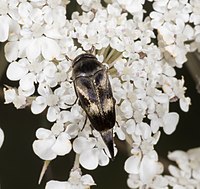Sting beetle
| Sting beetle | ||||||||||||
|---|---|---|---|---|---|---|---|---|---|---|---|---|

Mordella aculeata |
||||||||||||
| Systematics | ||||||||||||
|
||||||||||||
| Scientific name | ||||||||||||
| Mordellidae | ||||||||||||
| Latreille , 1802 |
The sting beetles (Mordellidae) are a family of beetles with around 2,000 species worldwide. In Europe they occur with 264 kinds . Many species are often found on flowers and make tumbling movements.
features
The mostly dark colored beetles are between 2 and 15 mm long. The sting beetles are characterized by strong hind legs, a curved body and often an elongated abdomen. In the larger forms, the end of the abdomen ( pygidium ) forms a long point. The body is flat arched above, below with much more pronounced arching and elongated, narrowed towards the back.
The larvae live in decaying or fragile wood that is overgrown by mycelia or mine in stems. Some species also cause gall formation .
The beetles can be found on old wood, rotten bridge railings, or, like the genus Mordellistena , usually very numerous on flowers and flowering shrubs with exposed nectar. They are very lively and make violent, tumbling movements when they are caught.
These seemingly tumbling movements are made up of a series of very fast individual jumps (duration per jump approx. 80 msec.). They result from the efforts of the beetles to move from the supine or side position back to a new take-off position. The single jump is to be interpreted as an exaggerated turning movement that is performed with one leg of the third pair of legs (metapodia). Depending on whether the left or right metapodium is used as a pedestal, the jump direction changes. The jump energy is variable because it is due to direct muscle work. The results are different jump widths and heights with rotation frequencies of up to 48 U / s (Mordellochroa abdominalis) measured around the center of gravity of the longitudinal axis of the body. An additional rotation around the transverse axis (lower frequency) ensures screwed somersaults (tumbling). The sting (pygidium) is meaningless for the jump. In contrast, the meta-trochanter in the coxa (thigh ring and hip of the third pair of legs) that is fused with the metathorax has a high degree of rotation (up to 270 °, with one degree of freedom), which is made possible by a real screw joint at the base of the coxa. The pitch of the screw nut is 21 °. (Detection with the scanning electron microscope, SEM 1985). Inferior, but also technically similar jumps can be found in the beetles with similarly built coxa-trochanteric joints of the neighboring families Melandryidae (= Serropalpidae) (genus Orchesia ) and Scraptiidae (genus Anaspis ), which, historically, suggest a more general origin of the ability to use this form of locomotion , so should not apply specifically only to the Mordellidae.
Other authors (2011) now also refer to the peculiarity of a real screw joint in nature. The weevils of the genus Trigonopterus (Curculionidae) from the tropical rainforests of Asia have an even closer connective construction of the coxa-trochanteric joint than that of the Mordellidae. The angular speed of the torque is not achieved as with the spiked beetles, since the joint is used here for better climbing and holding in the vegetation.
Types (selection)
- Glipa
- Hoshihananomia
- Mordella
- Mordellistena
- Mordellochroa
- Paramordellaria
- Tolidomordella
- Tomoxia
- Variimorda
- Yakuhananomia
literature
- Jiři Zahradnik, Irmgard Jung, Dieter Jung et al .: Käfer of Central and Northwestern Europe , Parey, Berlin 1985, ISBN 3-490-27118-1
- Leopold Mader: The insect life of Austria , Hölder-Pichler-Tempsky A.-G., Vienna 1922.
- Michael Reuter: Functional morphological studies on the jump of the sting beetles (Mordellidae, Coleoptera) Diss. Münster / W. 1985
- Michael Reuter: Functional morphological studies on the jump of the sting beetle (Mordellidae, Coleoptera) , Acta biologica benrodis 7, 99-133 (1995)
- Karl Ermisch: 79. Family Mordellidae : in joy, Harde, Lohse: Die Käfer Mitteleuropas, Bd. 8 Goeke u. Evers - Verlag, Krefeld 1969
Web links
credentials
- ↑ Mordelliidae. Fauna Europaea, accessed May 22, 2009 .
- ^ Edmund Reitter: Fauna Germanica. The beetles of the German Empire. KG Lutz, Stuttgart 1911.
- ↑ Michael Reuter: Functional morphological studies on the jump of the sting beetles (Mordellidae, Coleoptera) , Acta biologica benrodis 7, 99-133 (1995)
- ^ Van de Kamp, Thomas; Vagovic, Patrik; Baumbach, Tilo; Riedel, Alexander: A Biological Screw in a Beetle's Leg . In: Science . tape 333 , no. 6038 , July 1, 2011, p. 52-52 , doi : 10.1126 / science.1204245 , PMID 21719669 .


